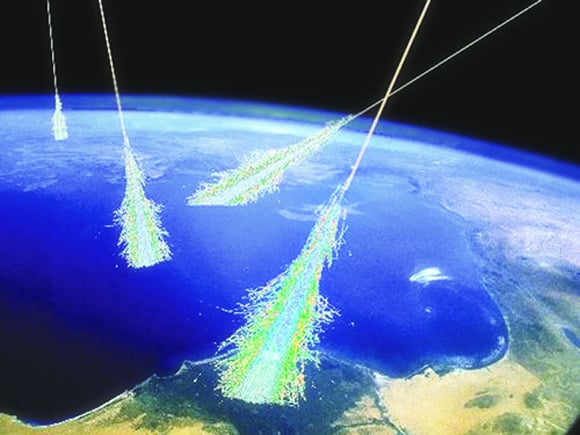[/caption]
When a moderate-sized M-class flare erupted from the Sun on May 17, it sent out a barrage of high-energy solar particles that belied its initial intensity. These particles traveled at nearly the speed of light, crossing the 93 million miles between the Sun and Earth in a mere 20 minutes and impacting our atmosphere, causing cascades of neutrons to reach the ground -- a rare event known as a
ground level enhancement
, or GLE.
The first such event since 2006, the GLE was recorded by a joint Russian/Italian spacecraft called
PAMELA
and is an indicator that the peak of solar maximum is on the way.
The PAMELA spacecraft -- which stands for
P
ayload for
A
ntimatter-
M
atter
E
xploration and
L
ight-nuclei
A
strophysics -- is designed to detect high-energy cosmic rays streaming in from intergalactic space. But on May 17, scientists from NASA's Goddard Space Flight Center convinced the Russian team in charge of PAMELA to grab data from the solar event occurring much closer to home.
[caption id="attachment_95584" align="alignright" width="225" caption="This graph shows the neutrons detected by a neutron detector at the University of Oulu in Finland from May 16 through May 18, 2012. (University of Oulu/NASA's Integrated Space Weather Analysis System)"]
[/caption]
The result: the first observations from space of the solar particles that trigger the neutron storms that make up a GLE. Scientists hope to use the data to learn more about how GLEs are created, and why the May 17 "moderate" solar flare ended up making one.
"Usually we would expect this kind of ground level enhancement from a giant coronal mass ejection or a big X-class flare," said Georgia de Nolfo, a space scientist at NASA's Goddard Space Flight Center. "So not only are we really excited that we were able to observe these particularly high energy particles from space, but we also have a scientific puzzle to solve."
Fewer than 100 GLEs have been recorded in the last 70 years, with the most powerful having occurred on February 23, 1956. Like most energetic solar outbursts, GLEs can have disruptive effects on sensitive electronics in orbit as well as on the ground, and based on
recent studies
may even have adverse effects on cellular systems and development.
[caption id="attachment_95585" align="aligncenter" width="580" caption="The M-class flare from AR 1476 on May 17, 2012 (at right) Courtesy NASA/SDO and the AIA science team."]
[/caption]
Read more on the NASA news release
here
.
 Universe Today
Universe Today
